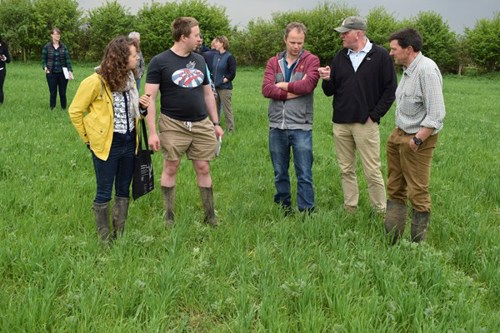A group of organic and conventional farmers are researching the benefits of growing two crops in a field rather than one. We visited organic beef farmer James Hares on his farm in Wiltshire to ask him about his experience of farmer-led research.

James (second from left) discusses the progress of the intercropped beans and wheat with other farmers in the field lab
Can you explain your research in a nutshell and how you started?
On our farm we’re growing beans as a crop for our cattle feed, but we needed to find a way to reduce the weed burden in the crop. So, we decided we should grow something to replace those weeds. We chose to use wheat because we had some spare seed in the back of the shed! This first kicked us off on our intercropping journey. We had a very disastrous bean crop the year before trying intercropping only harvesting a third of the field that we planted. The rest of the field was absolutely infested with thistles. Something had to be done. It worked quite well. We ended up with a 62% reduction in fresh weight weeds and a 74% reduction in dry matter of weeds. I would call that a success.
Being organic, we can’t spray off our weeds – we must think of a way of killing them using biology rather than chemistry. But there could also be other benefits. This year we’re doing some protein analysis so see whether our beans, being a legume, will help fix nitrogen for our wheat to increase the protein levels. If it does that would be a bonus. To sell the wheat, we’d have to invest in separation technology, so it’d be hard to afford for our scale of arable production. But it depends on whether it’s worth it. At the end of the day, it’s a numbers game.
Why do you think more farmers are trying intercropping in the UK?
I think that people are looking more at their inputs and the cost of them – they are trying to figure out ways to be more efficient to futureproof their businesses. The more people who try it and see it working, the more people will keep trying it.
How did you first get involved in farmer led research?
My Dad (Adrian Hares) has been part of another Innovative Farmer group involving soil and root innovation. Looking at trying to make phosphate more available through co-composting of manure. So, we were already aware of field labs and Innovative Farmers. And then this idea of intercropping came up and it sounded interesting, so we went along to an event at the Organic Research Centre. But we had already planted ours by the time we went along to the meeting!
What has been your experience of doing research on the farm?
The biggest challenge with doing research on farm is time. We get busy and then things drop to the back of a long list of things to do. The challenge is to keep on top of timings of when we want to be checking on tillers, how tall the crop is, what growth stage it’s at, etc. Time management on field labs is always going to be harder, particularly when you have cattle that you have to feed every day.
What lessons would you share with other farmers?
I would tell other farmers trying research not to be afraid to give something a go on a small patch to start off with and then you can always make it bigger. That’s what we did. We started off with a one hectare intercropping plot and the rest of the field was monoculture. And this year we flipped it around and did one hectare of monocrop and the rest was intercropped. Just be prepared to move with what the results are telling you.
Where will you be taking the trial next year?
It depends on what the harvest tells us. Potentially, we’ll be fiddling around with the seed rates again because we haven’t quite got the bean populations where we’d like them. We may need slightly fewer wheat seeds per square metre.
Have you got any comments on the need for more farmer-led research?
I think farmer-led research is necessary because everyone’s farm is different. The reason we do it is because no one has soil like ours – none of the bigger farmers do trials or field labs on heavy land and our land is heavy. To find anything out we must do it ourselves – every farm is different so every farmer should be trying new things.
Get involved in your own farmer-led research
To keep informed of how this field lab and others are progressing sign up and become a member of the Innovative Farmers network. Got your own idea for a field lab? Add it to our ideas pinboard.